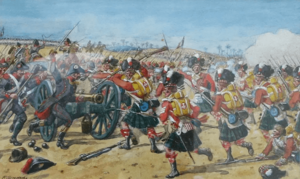Battle of Mandora facts for kids
Quick facts for kids Battle of Mandora |
|||||||
|---|---|---|---|---|---|---|---|
| Part of the French Campaign in Egypt and Syria of the French Revolutionary Wars | |||||||
 92nd (Gordon Highlanders) Regiment of Foot at the Battle of Mandora, a waterclour by Richard Simkin (1850–1926). |
|||||||
|
|||||||
| Belligerents | |||||||
| Commanders and leaders | |||||||
| Strength | |||||||
| 13,000 | 7,000 | ||||||
| Casualties and losses | |||||||
| 185 killed 1,136 wounded 1 missing |
700 | ||||||
The Battle of Mandora was a smaller fight that happened on March 13, 1801. It was part of the French campaign in Egypt and Syria. British forces led by Ralph Abercromby fought against French forces led by François Lanusse. The battle took place near Alexandria, Egypt. The British won this battle.
Why the Battle Happened
The British army, led by Ralph Abercromby, was sent to Egypt. Their goal was to remove the French army from the area. The French leader, Napoleon, had left Egypt in 1799.
On March 1, 1801, the British arrived by ship at Abu Qir Bay. This bay was about 23 kilometers (14 miles) from Alexandria. The British force had about 15,300 soldiers. Many were sick, but they had a large fleet of 175 ships.
On March 8, about 5,500 British soldiers landed by boat. They faced about 2,000 French soldiers from Alexandria. The French were on sand dunes overlooking the beach. This fight was called the Second Battle of Abukir. The British quickly won this landing. They used a bayonet charge to take the main French position. By nightfall, all British soldiers were on shore.
After landing, the British set up a supply base and a hospital. They then captured Aboukir Castle from the French. They started getting ready to move towards Alexandria. On March 12, the British began to advance. They moved along a narrow strip of land between the Mediterranean Sea and Lake Maadie. They camped for the night near a place called Mandora Tower.
Meanwhile, the main French commander, Jacques-François Menou, was in Cairo. He thought the British landing was not a big threat. He sent only a small group of soldiers to Alexandria. This group was led by François Lanusse. Lanusse was eager to fight and decided to attack the slowly advancing British.
The Battle of Mandora
General Abercromby checked the area himself. He saw that nearly 5,000 French soldiers were on a high ridge. This ridge crossed the western end of the land strip. The French had built a strong defensive position there. It stretched from the ruins of Nicopolis in the north to the Alexandria Canal in the south.
On March 13, the British began their attack at dawn. They advanced in two lines. The French opened fire with cannons and muskets. They heavily attacked the 92nd Regiment of Foot, which was leading the left British column. The French also launched a cavalry charge against the 90th Regiment of Foot on the right. Most of the French cavalry were stopped by British musket fire.
As the British lines moved forward, the French began to pull back. They retreated to their stronger defenses outside Alexandria. Dillon's Regiment, a group of foreign soldiers fighting for the British, captured two French cannons. They did this with a bayonet charge near the canal.
The British now held the positions the French had left. Abercromby wanted to capture the French forts outside Alexandria quickly. He ordered a further advance across the flat land between the two ridges. General Hutchinson was told to take a hill to the south. His soldiers, including the 44th Regiment of Foot, successfully captured a bridge over the canal.
However, General Moore, leading the right column, faced heavy cannon fire. His soldiers were completely exposed. Abercromby stopped the advance to check the area himself. His horse was shot from under him. As evening came, the British forces pulled back. They returned to the line they had captured earlier that day.
What Happened Next
The British started to make their new position stronger. They brought heavy cannons from their ships. They also brought up supplies. Their plan was to surround the French soldiers in Alexandria.
A few days later, on March 21, the French launched a counterattack. This led to the Battle of Alexandria. The British defeated the French in this larger battle.
The British 90th Regiment of Foot and 92nd Regiment of Foot fought very bravely at Mandora. Because of their actions, they were given the special award "Mandora."
The Mandora Barracks, a military camp built in 1895 in Aldershot, England, was named after this battle. It was torn down in 1970.
Images for kids


